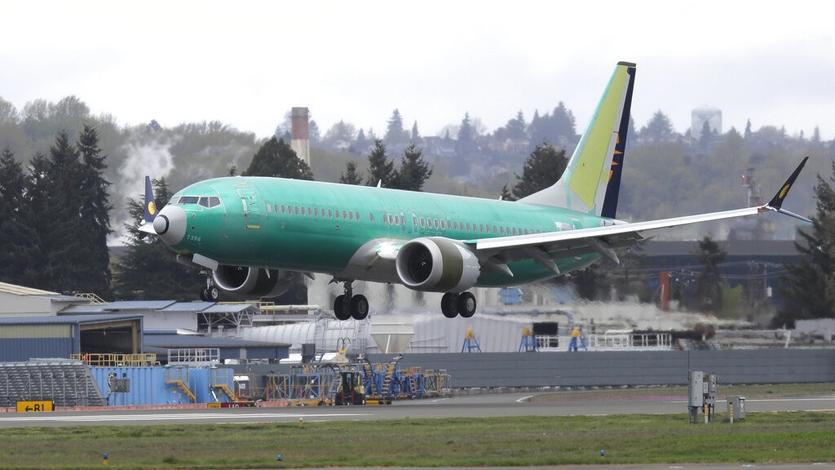 In this April 10, 2019 photo, a Boeing 737 MAX 8 airplane being built for India-based Jet Airways lands following a test flight at Boeing Field in Seattle. (TED S. WARREN / AP)
In this April 10, 2019 photo, a Boeing 737 MAX 8 airplane being built for India-based Jet Airways lands following a test flight at Boeing Field in Seattle. (TED S. WARREN / AP)
WASHINGTON / SEATTLE - After nearly two years of scrutiny, corporate upheaval and a standoff with global regulators, Boeing Co is set on Wednesday to win approval from the US Federal Aviation Administration to fly its 737 MAX jet again after two fatal disasters.
The FAA will detail software upgrades and training changes Boeing must make in order for it to resume commercial flights after a 20-month grounding, the longest in commercial aviation history.
The FAA will detail software upgrades and training changes Boeing must make in order for it to resume commercial flights after a 20-month grounding, the longest in commercial aviation history
The 737 MAX crashes in Indonesia and Ethiopia killed 346 people within five months in 2018 and 2019 and triggered a hailstorm of investigations, ousted executives, frayed US leadership in global aviation and cost Boeing some US$20 billion.
The US planemaker’s best-selling jet will resume commercial service facing strong headwinds like a resurgent coronavirus pandemic, new European tariffs, and mistrust of one of the most scrutinized brands in aviation.
“Our family was broken,” Naoise Ryan, whose 39-year-old husband died aboard Ethiopian Airlines flight 302, told a news conference on Tuesday. “We are suffering and we’ll most likely continue to suffer for a very long time, if not for the rest of our lives.”
READ MORE: Virus: Boeing lifts 20-yr forecast for China aircraft demand
The 737 MAX is a re-engined upgrade of a jet first introduced in the 1960s. Single-aisle jets, like the MAX and Airbus’ rival A320, are short-haul workhorses that dominate global fleets and provide a major source of industry profit.
Anticipating FAA approval, American Airlines plans to relaunch commercial MAX flights on Dec. 29. Southwest Airlines, the world’s largest MAX operator, does not plan to fly the aircraft until the second quarter of 2021.
When it does fly, Boeing will be running a 24-hour war room to monitor all MAX flights for issues that could impact the jet’s return, from stuck landing gear to health emergencies, three people familiar with the matter said.
LONG RUNWAY AHEAD
FAA Administrator Steve Dickson is expected to sign an order lifting the flight ban on Wednesday and the agency is set to release an airworthiness directive detailing the required changes.
The US planemaker’s best-selling jet will resume commercial service facing strong headwinds like a resurgent coronavirus pandemic, new European tariffs, and mistrust of one of the most scrutinized brands in aviation
The FAA is requiring new pilot training and software upgrades to deal with a stall-prevention system called MCAS, which in both crashes repeatedly and powerfully shoved down the jet’s nose as pilots struggled to regain control.
Leading foreign regulators in Europe, Brazil and China also must issue their own approvals after independent reviews - illustrating how the 737 MAX crashes upended a once US-dominated airline safety system in which nations large and small for decades moved in lock-step with the FAA.
The FAA, which has faced accusations of being too close to Boeing in the past, said it would no longer allow Boeing to sign off on the airworthiness of some 450 already-built 737 MAXs. So it plans in-person, individual inspections that could take a year or more to complete, prolonging the jets’ delivery.
Boeing meanwhile is scrambling to keep up maintenance and find airline buyers for many of its mothballed 737 MAXs since the coronavirus downturn sapped airlines’ desire to refresh fleets.
ALSO READ: FAA 'could lift Boeing 737 Max grounding as early as Nov 18'
Even with all the hurdles, resuming deliveries of the 737 MAX will open up a crucial pipeline of cash for Boeing and hundreds of parts suppliers whose finances were strained by production cuts linked to the jet’s safety ban.
Numerous reports have faulted Boeing and the FAA on the plane’s development. A US House of Representatives report in September said “Boeing failed in its design and development of the MAX, and the FAA failed in its oversight of Boeing and its certification of the aircraft.”
The report said Boeing made “faulty design and performance assumptions,” while it also criticized Boeing for withholding “crucial information from the FAA, its customers, and 737 MAX pilots” including “concealing the very existence of MCAS from 737 MAX pilots.”
The House on Tuesday unanimously passed a bill to reform how the FAA certifies airplanes, while a Senate panel is to consider a similar bill on Wednesday.



